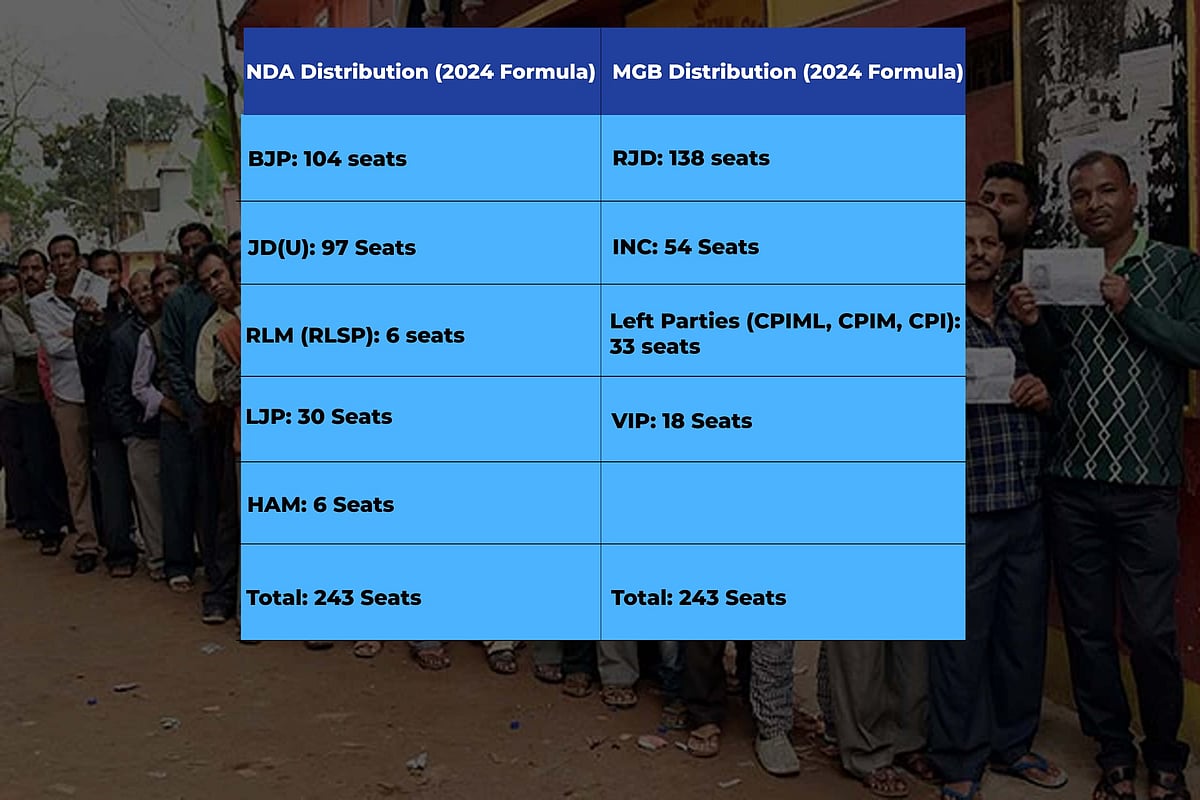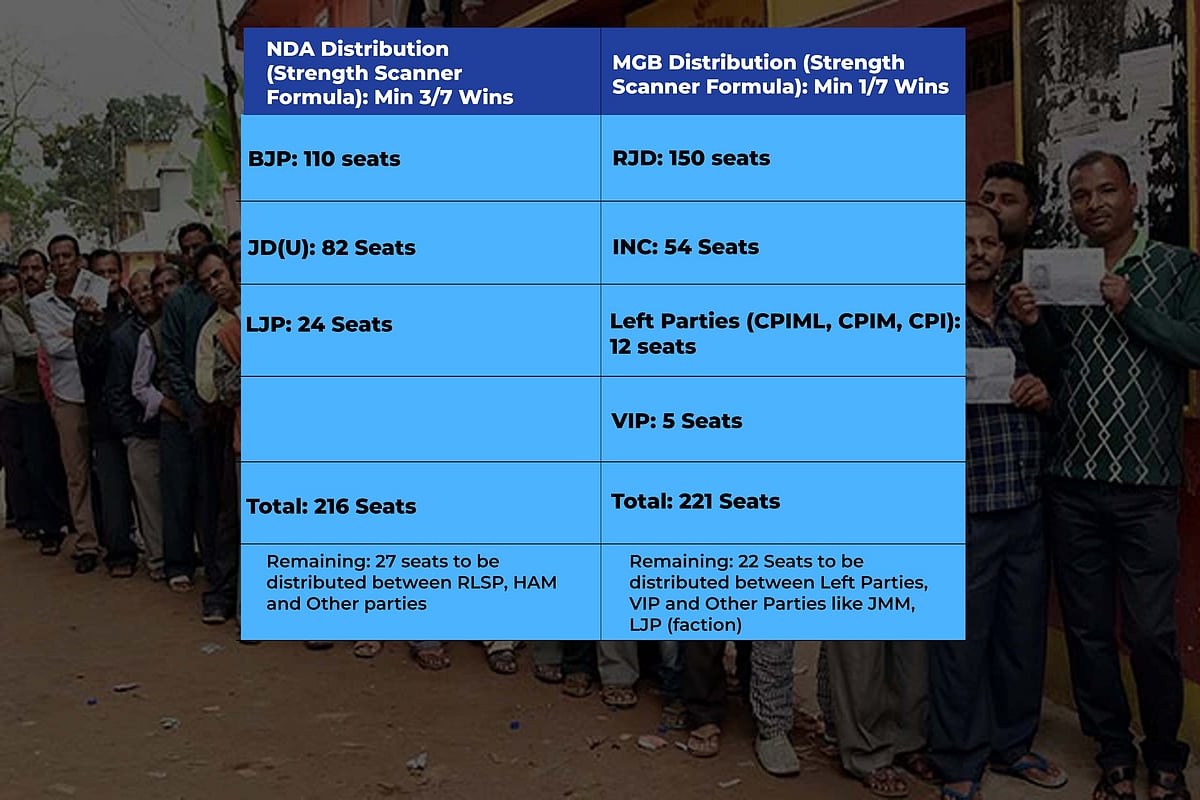Bihar Elections 2025: Decoding Ticket Distribution Muddle In NDA, Mahagathbandhan
Smaller parties like VIP, JMM in MGB and LJP, HAM, RLM in NDA could even ditch alliance or switch sides if given a lesser number of seats.

As Bihar prepares for its 2025 assembly elections, both major alliances — the National Democratic Alliance (NDA) and the MahaGathbandhan (MGB) — find themselves entangled in a complex web of seat-sharing negotiations. With 243 assembly constituencies at stake, the question of which party gets how many seats in an alliance and who gets which seat has become a contentious issue that could determine the electoral fortunes of both alliances.
Smaller parties like VIP, JMM in MGB and LJP, HAM, RLM in NDA could even ditch alliance or switch sides if given a lesser number of seats. With multiple parties claiming the same seat, finalisation of seat in favour of one party and denial to another, could lead to rebel candidates from both sides contesting as Independents or from Jan Suraj Party (JSP) denting their prospects.
The Distribution Dilemma
The core challenge facing both alliances is striking a balance between accommodating allies, rewarding past performance, and maximizing electoral prospects. Each constituent party believes it deserves a larger share of seats, creating a mathematical puzzle where ambitions far exceed availability.
The NDA comprises the Bharatiya Janata Party (BJP), Janata Dal (United) (JD(U)), Hindustani Awam Morcha (HAM), Rashtriya Lok Morcha (RLM, formerly RLSP), and Lok Janshakti Party (LJP). Meanwhile, the MGB includes the Rashtriya Janata Dal (RJD), Indian National Congress (INC), Left parties, Vikassheel Insaan Party (VIP), JMM (Jharkhand Mukti Morcha) and a faction of LJP headed by uncle of Chirag Paswan.
Internal tensions within alliances are inevitable. The JD(U) might point out that the LJP (ostensibly backed by BJP) pushed it to third place in five constituencies during the 2020 elections, questioning whether seats should be allocated based purely on winner-runner-up status. Similarly, the RJD could highlight the Congress party’s relatively poor strike rate compared to the CPI(ML)'s impressive conversion rate, arguing for a redistribution that rewards electoral efficiency.
Option 1: The 2020 Results Formula
The most straightforward approach would base seat distribution on the 2020 assembly election results, giving first claim to parties that emerged as winners or runners-up in each constituency.

This formula shows lesser issues for MGB on paper, clearing 242 of the 243 seats. However, this creates its own problems—it leaves virtually no room for negotiation or accommodating smaller allies, JMM and LJP (faction), leaving just 1 seat for these 2 parties.
The NDA faces the challenge of distributing 19 seats among partners who are all demanding more representation specially JDU which wants to still play the role of bigger brother and LJP which is sulking and has a history of rebelling in 2020 and damaging NDA prospects making the elections close.
The 2020 formula fails to take into account who may have performed better in other elections like by-polls and general elections 2024. It also fails to account for changing political dynamics.
Option 2: The 2024 Lok Sabha Contest
An alternative approach considers the more recent 2024 Lok Sabha elections. This provides a fresher snapshot of each party's current electoral standing.

The 2024 formula produces a perfect mathematical fit for both alliances, with each coalition's claims totaling exactly 243 seats. This reflects the more recent voter preferences and gives recognition to parties like the LJP, which contested more aggressively in the parliamentary elections.
However, this formula has its critics. Lok Sabha elections operate under different dynamics than assembly polls—voters often make different choices when electing their MP versus their MLA. National issues and leadership personalities dominate parliamentary contests, while local factors, caste equations, and state-level governance record matter more in assembly elections. Using Lok Sabha distribution as a template may not accurately fit assembly election distribution.
Option 3: The Strength Scanner Approach
The most comprehensive—and perhaps fairest—method is the "Strength Scanner" that analyzes long-term electoral performance of parties across multiple election cycles and assesses their individual strength. Since the 2008 delimitation, Bihar has witnessed seven major elections: the 2009, 2014, 2019, and 2024 Lok Sabha polls, and the 2010, 2015, and 2020 assembly elections.
If a party is winning a seat consistently in lok sabha as well as vidhan sabha polls, which are fought on different issues, shows that the seat is safe.
This method categorizes seats based on consistency:
Very Strong: A seat is categorised as Very Strong for a party if it has won that seat 6-7 times out of last 7 elections
Strong: If Won 4-5 times in last 7 polls
Moderate: If Won 3 times in last 7 polls
Difficult: If Won 1-2 times in last 7 polls
Weak: If not won ever in any of the last 7 polls (including did not contest seats)
Initially, parties that have won a seat at least three times in the last seven polls should have the primary claim to that constituency. While NDA having won in 2010 and 2020 fit well in this formula, MGB loss in these elections makes it difficult to adopt. There are only 45 seats which MGB partners have won minimum thrice in the last seven polls. So for MGB at least 1 out of 7 wins is considered for a claim to a seat.

The stark disparity in criteria, 3/7 for NDA and 1/7 wins for MGB reveals this formula's limitation—it heavily favors parties with longer periods in power and doesn't adequately represent the opposition's current strength. RJD's political wilderness between 2005 and 2015 reflects its lesser number of strong and very strong seats, while the Congress's minimal showing highlights its long-term decline in Bihar.
This revised approach provides a more realistic distribution for the MGB, though it still leaves 22 seats to be distributed for smaller partners. The Left parties' modest 12-seat claim might seem low given their 2020 strong performance. However, it reflects their concentrated strength in specific pockets rather than statewide appeal.
27 seats are left to be distributed in NDA through this method with HAM and RLM claiming most of them while JDU’s lower seats compared to BJP reflects its decision to contest 2014 general elections on a standalone basis which impacted its performance negatively winning just 2 of the 40 lok sabha seats.
The Path Forward
Each formula has its merits and drawbacks. The 2020 results offer recency and relevance to assembly dynamics but may be outdated given political realignments, VIP switch from NDA to MGB, LJP gharwapsi in NDA. The 2024 Lok Sabha contest provides the freshest data but conflates parliamentary and assembly voting patterns. The Strength Scanner offers historical perspective and rewards consistent performance but may not capture emerging trends or recent shifts in voter sentiment.
The reality is that no mathematical formula alone can resolve the ticket distribution puzzle. Political negotiations would in the end balance quantitative analysis with qualitative factors: leadership strength, caste arithmetic, anti-incumbency waves, candidate quality, and local organizational capacity.
Both alliances will likely adopt a hybrid approach, using elements from all three formulas while making strategic adjustments based on ground realities. As the election draws near, the final seat-sharing arrangement will test each alliance's unity / cohesion and strategic acumen. In Bihar's fractured political landscape, where margins of victory are often razor-thin, 78 seats decided on a margin of <=5%, the difference between a well-negotiated and poorly negotiated seat distribution could be the difference between forming a government and sitting in opposition.
Disclaimer: The views expressed here are those of the author and do not necessarily represent the views of NDTV Profit or its editorial team.

